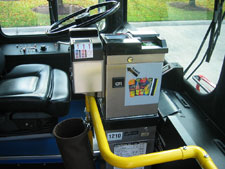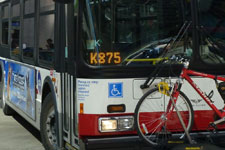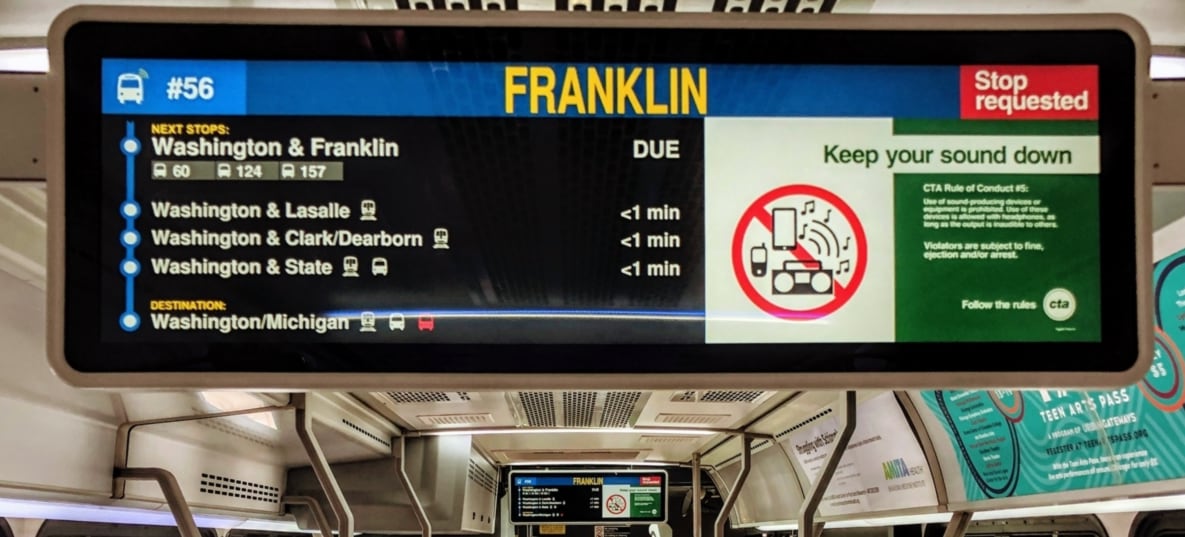Operations
If you are a CTA rider looking for general transit information, please visit the official CTA website.
Routes
The CTA has 129 bus routes that serve more than 1,536 miles and 10,768 bus stops. The latest route map, along with individual bus schedules, is available for download on the official Chicago Transit Authority web site.
Fare Collection

(For information regarding current CTA fares, please visit the faretable on CTA’s web site.)
Cash fares are collected on CTA buses using GFI Genfare fareboxes that were purchased in 1986. The equipment accepts both dollar bills and coins. An extension from Cubic Transportation Systems was added to the fareboxes in the mid-90s to allow for the processing of magnetic strip transit cards and the Chicago Card/Chicago Card Plus smart cards, both of which have since been discontinued in favor of Ventra system.
In 2011, the CTA awarded a contract to Cubic Transportation Systems for implementation of a new open fare system that would later be branded as Ventra. The system went live in late 2012, with all other non-cash forms of payment discontinued by July 1, 2014. The Ventra system allows customers to pay with Ventra-issued contactless cards, single-use contactless paper "tickets", as well as any contactless bank card or mobile device.
In 2019, Ventra announced a partnership with Apple, Inc to allow virtual Ventra Cards to be stored on Apple's iPhone and Apple Watch products. As part of the integration, which went live in late 2020, Ventra began supporting Apple's "Express Transit" feature, allowing customers to tap supported iPhones and Apple Watches to Ventra fare readers without needed to authenticate.
Run Numbers

Like most transit systems, the CTA uses run numbers to keep track of its daily bus runs.
The run number for a bus is displayed in the lower corner of the windshield. Run numbers contain three pieces of information about that particular run. The first letter or number is the garage code for the bus’ assigned garage. The remaining digits provide information about the route number and run type (Full-time, block run, or part-time).
Run numbers are assigned based on earliest finish, and in cases of interlining, based on the route the run spends most of its time operating. Extra routes for schools or special events are often assigned in order of report time, rather than finish time.
Visit the garages section for the latest available list of bus route run numbers.
Technology
CTA buses employ numerous technology offerings from Clever Devices. Each bus contains an Intelligent Vehicle Network (IVN) computer that powers designation signs, automated next-stop announcements, automated vehicle location (Bus Tracker), and passenger counters.
Destination Signs


All CTA buses use either flip-dot or LED signs for displaying route and destination information.
6400-series Nova buses #6400 thru #6708 use LED-backlit flip-dots. Backlit flip-dots improve upon the original flip-dot technology from the 1990s, as they are illuminated by LEDs behind each mechanical dot. Historically, flip-dot signs received illumination only by a florescent bulb. Visit Wikipedia for more information on flip-dot display technology.
6400-series Nova buses #6709 thru #6883 were the first CTA buses to use amber LED destination signs. LED signs allow for maximum visibility at night and are less prone to mechanical issues. LED signs became standard on all CTA buses following the 6400-series.
Destination signs are controlled by the Clever Devices’ Intelligent Vehicle Network. The destination sign is set automatically when the driver enters his or her run number into a control panel. When the bus reaches its terminal, the destination sign automatically changes to reflect the next trip.
Automated Voice Annunciation System
In 2002, the CTA began installing an automated voice annunciation system (AVAS) from Clever Devices on all buses. This system automatically makes next-stop and external route identification announcements. Whenever the bus doors open, the route name and desintation is announced through an external speaker (eg. “Route 29 State to Navy Pier”). Inside the bus, next-stop information is communicated both audibly and visually. Approximately one block before a stop, the name of the stop is announced through the bus’ public address system. The stop name is also displayed on electronic signs inside the bus. In addition to showing the next stop, the signs also display the current time and date along with the “Stop Requested” notice. The system also plays public service announcements at varying intervals.
The announcement system works using both global positioning (satellite-based) and logical positioning (distance-based) systems to determine the location of a bus and make the appropriate next-stop announcement.
Passenger Counting
All CTA buses make use of an automatic passenger counting system from Clever Devices. Passengers are counted as they board and alight the bus and records are kept with relationships to individual stops, routes, and runs. Passenger counting is performed using a dual beam infrared sensor located at both the front and rear doors. The sensor counts each passenger in the direction they pass the sensors. Passenger counts are stored on the bus and downloaded into a master database.
Bus Tracker

On August 5, 2006, the CTA launched the Bus Tracker pilot program. Bus Tracker allows riders to view estimated arrival times of buses along a particular route. The service is available on the web at ctabustracker.com, via text message using instructions posted at each bus stop, and at select bus shelters with Bus Tracker signs. The CTA also makes available Application Programming Interfaces (APIs) that allows software developers to create third-party apps for viewing Bus Tracker information on computers and mobile devices.
Bus Tracker is powered by Clever Devices’ BusTime technology. The system harnesses global positioning satellite technology previously installed on buses as part of the automated voice annunciation system. Wireless cellular data modems are installed on buses to transmit location data to servers in real time. Allowing customers to track bus locations is only one benefit of the technology, as field supervisors are also able to use the data to reduce bus delays and bunching.
On-board Bus Displays

As part of the installation of its automated voice annunciation system in 2002, CTA began including single-line LED displays on the interior of its buses, replacing the static "Stop Requested" signage posted above the windshield. These displays communicated the next stop, time and date, stop requests, and a transcript of public service announcements.
In 2019, the CTA began testing updated interior digital information screens. The screens, which use LCD-based display technology, can communicate real-time route information, stops requests, advertisements, and passenger updates. Each 40-foot bus with the equipment features two ceiling-mounted signs, one posted at the front of the bus and another closer the rear doors.
Radio Frequencies
You can monitor the activities of the CTA on the following radio frequencies:
- Bus Supervisor Channels: 470.5375, 470.6375
- CPD Transit Detail: 472.9375